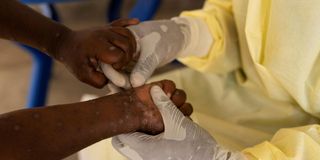Prime
Risk of mpox strain in children a worry

A nurse takes a sample from a child declared a suspected case of Mpox - an infectious disease caused by the monkeypox virus that sparks off a painful rash, enlarged lymph nod.
What you need to know:
The issue:
Mpox
Our view:
State actors can, however, lobby for support from the global north to undertake purposeful activities around surveillance and education.
When the World Health Organization (WHO) declared the current outbreak of the mpox virus “a public health emergency of international concern” on August 14, the Health ministry unsurprisingly vowed to ramp up surveillance efforts. There were few doubting Thomases, if any. Uganda’s track record of dealing with outbreaks of zoonotic diseases like Ebola is admirable, to say the least.
The epicentre of the current mpox outbreak is the Democratic Republic of the Congo (DRC) where the viral disease that causes painful rashes accompanied by flu-like symptoms continues to leave a trail of devastation. Uganda’s western neighbour, thanks in no small part to the highly virulent mpox strain of clade Ib, accounts for 96 percent of all the viral disease’s cases and 97 percent of all deaths this side of the year.
It is perhaps hardly surprising that the four mpox cases and counting Uganda has registered can be traced back to the DRC. Yet even with state actors in Uganda having raised the country’s risk level assessment for mpox, the 950-kilometre border shared with the DRC remains notoriously difficult to police. Last week, a truck driver with a history of travel to the DRC passed through Uganda before surveillance efforts at the Malaba One Stop Border Post flagged him as an mpox positive case as he sought to enter Kenya.
It is possible that Kenya’s second mpox case was not red-flagged in Uganda because the highly contagious virus—that can be spread through skin-on-skin contact, the sharing of contaminated materials and contact with animals—was incubating. The incubation period is anywhere between three and 17 days.
The porousness of the Uganda-DRC border, however, means that the role of a malfunctioning sieve cannot be entirely discounted. With empirical evidence showing that children are more susceptible to mpox’s clade Ib variant, Ugandan health authorities should use the current second term holidays in schools to batten down the hatches. More so school communities near the Uganda-DRC border. While most people—children inclusive—people recover from mpox without medical treatment, it should not be lost upon us that the viral disease has a mortality rate of about four percent.
Responsible authorities should therefore do everything within their power to concentrate minds. They can find solace in the undisputed fact that the current mpox outbreak can be brought to control with the right collaboration. With the price of an mpox jab estimated at $100, a mass vaccination programme will clearly be beyond the reach of the Ugandan government.
State actors can lobby for support from the global north to undertake purposeful activities around surveillance and education. This will, doubtless, help if not nip mpox in the bud then stop a bad situation from becoming worse. WHO this week launched a global Strategic Preparedness and Response Plan slated to run from September 2024 to February 2025.
Uganda should position itself to benefit from the plan that, per the United Nations agency, will provide “timely evidence-based guidance, and access to medical countermeasures for the most at-risk groups in affected countries.” This belated sense of urgency and focus is duly welcomed.




